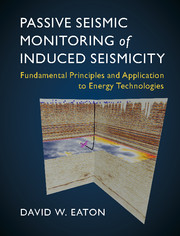 Passive Seismic Monitoring of Induced Seismicity
Passive Seismic Monitoring of Induced Seismicity Book contents
- Frontmatter
- Contents
- Preface
- List of Symbols
- Part I Fundamentals of Passive Seismic Monitoring
- 1 Constitutive Relations and Elastic Deformation
- 2 Failure Criteria and Anelastic Deformation
- 3 Seismic Waves and Sources
- 4 Stress Measurement and Hydraulic Fracturing
- Part II Applications of Passive Seismic Monitoring
- Appendix A Glossary
- Appendix B Signal-Processing Essentials
- Appendix C Data Formats
- References
- Index
2 - Failure Criteria and Anelastic Deformation
from Part I - Fundamentals of Passive Seismic Monitoring
Published online by Cambridge University Press: 07 June 2018
- Frontmatter
- Contents
- Preface
- List of Symbols
- Part I Fundamentals of Passive Seismic Monitoring
- 1 Constitutive Relations and Elastic Deformation
- 2 Failure Criteria and Anelastic Deformation
- 3 Seismic Waves and Sources
- 4 Stress Measurement and Hydraulic Fracturing
- Part II Applications of Passive Seismic Monitoring
- Appendix A Glossary
- Appendix B Signal-Processing Essentials
- Appendix C Data Formats
- References
- Index
Summary
Although we often hear that data speak for themselves, their voices can be soft and sly.
Frederick Mosteller (Beginning Statistics with Data Analysis, 1983)
The previous chapter emphasizes the elastic constitutive paradigm applicable to transient, recoverable deformation processes, which are accompanied by sufficiently small strain so that the stress–strain relationship is effectively linear. This chapter focuses on anelastic behaviour, which departs from the elastic constitutive model and leads to permanent deformation of a medium. Building upon concepts of the stress field and its tensor representation, this chapter deals with brittle and ductile failure processes that occur at levels of strain that are generally higher than for elastic behaviour. Brittle deformation is highly localized within the rock mass and accommodated by abrupt dislocation on new or preexisting fractures and faults, whereas ductile deformation results in permanent strain that is distributed more pervasively and occurs without fracturing, in response to an applied stress. The framework for understanding these distinct but interrelated processes derives from the diverse disciplines of geomechanics, fracture mechanics and earthquake mechanics. This chapter provides a brief introduction to fundamental principles related to these disciplines that are important for development of a complete understanding of induced seismicity.
Brittle Structures in Rock
Fractures are quasi-planar discontinuities in a rock mass. In an idealized sense, fractures are often described as surfaces, but at small scale they can be viewed as narrow tabular features with finite aperture (Fossen, 2016). Joints are a type of fracture across which there is negligible apparent shear displacement; joints can, however, have tensile (opening) displacement and are therefore sometimes referred to as opening fractures or dilatant fractures (Aydin, 2000). The generic term crack is often used interchangeably with either joint or fracture, especially in the material-science and rock-mechanics literature. Fractures tend to occur in sets that are approximately mutually parallel and regularly spaced. Intersecting sets of fractures form a fracture network.
Fractures and joints occur at a broad range of scales. In crystalline rocks the size distribution of fractures is usually characterized by a fractal or power-law distribution (Bonnet et al., 2001); however, in sedimentary rocks, mechanical bedding caused by lithologic layering can constrain the height distribution of vertical fracture sets as a result of fracture terminations at bedding boundaries, thus leading to stratabound fracture networks (Odling et al., 1999; Eaton et al., 2014a).
- Type
- Chapter
- Information
- Passive Seismic Monitoring of Induced SeismicityFundamental Principles and Application to Energy Technologies, pp. 29 - 50Publisher: Cambridge University PressPrint publication year: 2018
